#forms and phyla
Text
Phylum #1: Ctenophora, the comb jellies!
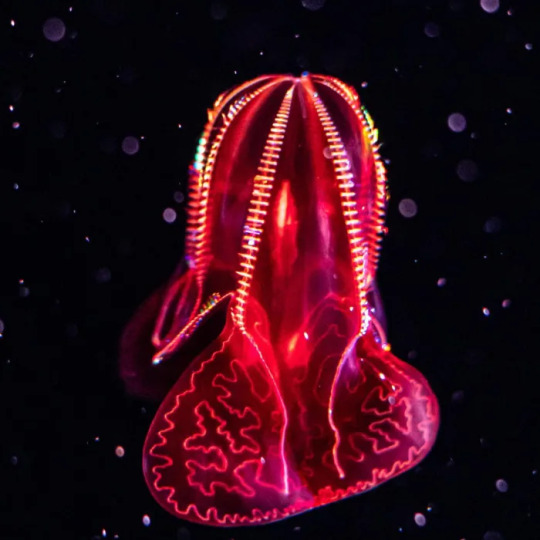


For quite a long time, it was believed that sponges were our most distant cousins, standing on the opposite side of the animal tree of life. Turns out it isn't the case - shiny, jelly-like creatures are the most alien of animals!
But these aren't true jellyfish, or anything close! Comb jellies don't sting, and don't have much in common with jellyfish except in appearance - in fact, they likely evolved most of their body plan completely independently!
They get their name from the rows of combs going down their body, with which they swim. These can often reflect light in unusual way, bringing a gamer vibe in the ocean depths!
Comb jellies come in a variety of shapes and sizes, not all jelly-like. Some scurry on the seafloor, while others look like huge floating ribbons. And some are even voracious predators, hunting... other comb jellies!
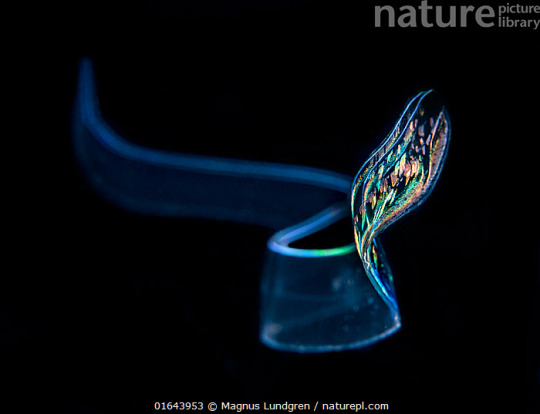

548 notes
·
View notes
Note
Why do the adult stages of insects have short lifespans?
Most animals can't reproduce, and most don't even develop the organ systems to do so, until almost the end of their development. Many mammals are actually rare freaks for their ability to start reproducing as little as a third into their lifespan, and keep reproducing over and over until they die; it's an extreme and radical survival strategy we evolved that comes with some pretty severe trade-offs, in that we have high energy demands and require so, so much food in proportion to most other organisms, not to mention all the ways those reproduction systems can take on illness, malfunction or hurt us.
Other animals like birds and reptiles and various fish opted instead to reach adult size as fast as they can, build the reproductive system, and then just take it easy: they live a long time and can mate more than once, but they don't do so constantly and don't make that many young.
The MOST common strategy in nature, basically the default norm is to devote most of your life just to eating, growing, and storing resources in your body, then "spend" all the resources you can on reproduction, giving so much of your energy to your babies that it actually kills you. The upside is that this is why most animals make hundreds or even thousands of young in one go, which better guarantees that at least one will survive.
Salmon and octopuses are two of the most famous non-insects that do it that way, but so do thousands of other mollusks, fish, members of the various "worm" phyla and others.
Many insect groups hyper-streamlined this, so they have a larval stage that's just an eating machine, like caterpillars and maggots, possessing only the bare minimum anatomy they need to keep on eating and growing and nothing else, usually incapable of even traveling from the same food source they were born on. They then use up all of this stored energy to create a body that is perfect for perpetuating their species, including more mobility (such as wings) to spread their population further.
Insects exhibit almost every variation there is, but many insect groups hyper-streamlined the basic method so they have a larval stage devoted to non-stop eating, like a caterpillar or a maggot, devoid of any anatomy that does not help it collect all the energy it can as continuously as it can, then use up that energy to build an equally dedicated mating form, which may last only days or weeks because it even gave up the ability to eat as it devoted as much of its body as possible to making those babies in that one big go.
There are still many exceptions including insects like cockroaches who mirror the mammal strategy of mating over and over for a relatively "long" adult life, or insects that still only mate the one time, but still at the end of a fairly long adult life that continues to eat and store energy.
The most extreme exception to this might be aphids, which continuously develop clone offspring and give live birth to them for their entire life, by which I mean some aphids are born already pregnant with their first clone. These actually still go through a normal mating process too, though, when a winged male finds them near the end of the year, and then they die after laying proper eggs that can survive the winter. The non-stop clone babies are just so that one female has even higher odds of mating with at least one of those males, because now there's 10,000 of her for him to find.
To understand basically everything in nature you just have to understand that:
1: life forms actually work like video game characters in that they constantly "farm experience" (nutrient energy) they have to spend on their unique spread of stats and abilities (every body part and system comprising them)
2: every life form evolves as if the only goal of that entire game is to generate offspring and increase the odds of their survival, literally no matter what must be sacrificed.
730 notes
·
View notes
Text
Happy New Year!
Let's imagine it was the Earth itself that was going into its 2024th year. That is to say, we're compressing the entire history of the Earth into just the past 2023 years. What events would have happened when?
Well, not too much is certain about the first couple decades after our planet formed, until around 50 CE when we were hit by another proto-planet, Theia, and the debris formed the Moon. After a couple years of the planet cooling down again, the oceans formed out of boiling rain. The timing of the origin of life is very uncertain, but there are chemical signs it may very well have happened as early as the second century. Around 200 CE, the gas giants did a big funky orbit-swapping dance, and in the process inflicted the Late Heavy Bombardment on the rest of the solar system, meaning the Earth was suffering a ton of meteorite strikes for the entire third century.
The first indisputable evidence of life is from around 330, and the first stromatolites appear around 470. Those are basically the first fossils, stones created by layer upon layer of oxygen-producing cyanobacteria living and dying on top of one another. But even with oxygen producers evolving, it would take many centuries before oxygen became a major part of the atmosphere: not until the Great Oxygenation Event, which happened during the ninth and tenth centuries. That's also about the time the first complex, eukaryotic cells evolved through a symbiosis between an anaerobic archaean and an oxygen-breathing bacterium. The bacterium became more and more focused on just the oxygen-breathing task inside the larger cell, until its descendants were mitochondria, which as you all know are the powerhouse of the cell. The next seven centuries passed by with only slow, gradual changes, and life continuing to be unicellular and difficult to find in the fossil record.

(1735's Snowball Earth, by me)
From 1704 to 1730, the entire planet froze over. After merely two years of thaw, it happened again, this time lasting from 1732 to 1742. But these snowball Earth episodes set the stage for the evolution of animals that began right after. Across the mid-18th century, the bizarre Ediacaran biota, with its strange symmetries, fronds, and fractal-like pattern filled the oceans. In the early 1780s they went extinct, possibly due to a temporary drop in oxygen-levels, only to be replaced by a great variety of quite different creatures in the Cambrian Explosion.
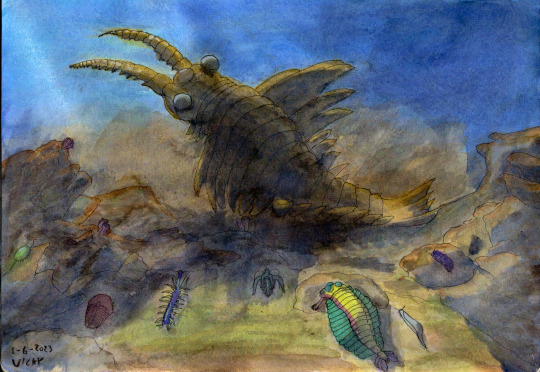
(Class of 1799, by me)
Starting in 1784 and running for a few decades, the Cambrian period saw the origin of most of the modern animal phyla, reaching its most famous form in the Burgess Shale fauna of 1799. During this time, most animals still lived on the sea floor, either attached or crawling, with relatively few actually swimming creatures. Plants started tentatively moving onto land around 1817, and in 1825, the rising of the great Appalachian mountains caused a severe drop in global CO2 and thus temperatures, leading to the Late Ordovician mass extinction.

(Horseshoe crabs and sea scorpions on a beach in 1834, by me)
Bony fish first showed up during the 1830s, and around the same time plants were getting serious about inhabiting the land, evolving roots and vascular tissues so they could properly grow there. Millipedes and the ancestors of spiders were the first animals to follow them onto land. Our own fishy ancestors did not take their first step until 1857, by which point the arthropods were well established there and the plants had figured out how to become trees. The Late Devonian extinction, partially caused by the evolution of said trees and partially by the south pole freezing, played out in two pulses over the late 1850s and early 1860s.
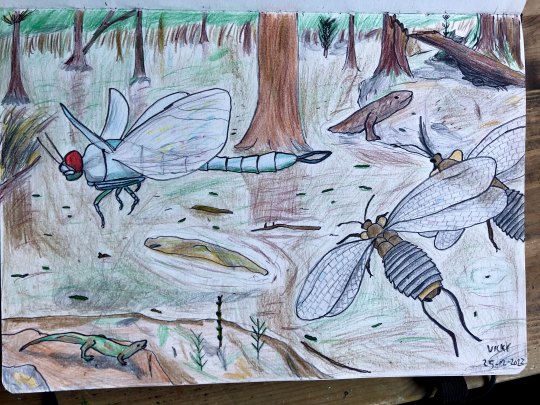
(Swamp prominently featuring Meganeura and Mazothairos in 1889, by me)
Arthropods and vertebrates continued to gain adaptations to life on land. The insects became the first creatures ever to fly in 1878, and the high-oxygen atmosphere of the time would be especially good to them. Around 1884, a group of vertebrates called the amniotes, after the membrane that kept water inside their eggs so they could lay them on land without them drying out, split into two groups: the reptiles and the synapsids (which we mammals descend from). The next few decades would see the synapsids in particular being extremely successful as the supercontinent Pangaea formed. Until 1912, when a massive episode of volcanism caused the worst mass extinction of all time, the Great Dying, scouring the Earth of a huge portion of its life.
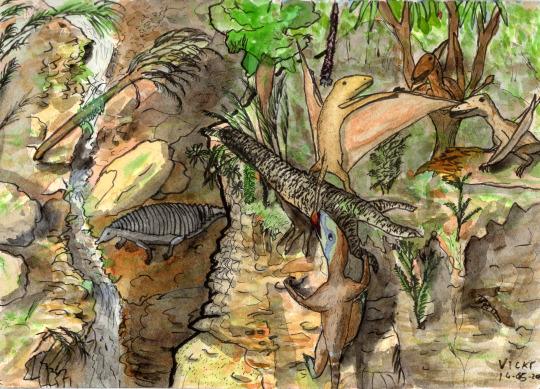
(A 1930 scene featuring the three branches of archosaur: dinosaur, pterosaur, and pseudosuchian, by me)
The 1910s were a period of slow recovery during which strange new forms of animal evolved. Many different, unrelated reptiles, such as the ichtyosaurs and plesiosaurs, went to sea, where they would continue to provide some of the most impressive creatures for most of the 20th century. On land, the dinosaurs first appeared in 1920, though for the next decade or so they'd live in the shadow of their pseudosuchian (crocodile-line) cousins. In 1934, Pangaea began to break up, resulting in another terrible pulse of volcanism that caused a lot of extinctions and left particularly the feathered and furry survivors with a lot of empty niches to fill, allowing the dinosaurs and mammals to diversify greatly. The last common ancestor of all modern mammals lived in the early 1940s, and by 1957 the dinosaurs had figured out flight, with Archaeopteryx usually being considered the first bird. Other dinosaurs took on an incredible variety of sizes, shapes, and forms. Some of the most famous ones include Dilophosaurus (1942), Diplodocus and Stegosaurus (1955), Iguanodon (1969), Velociraptor (1991), and Tyrannosaurus rex (1994).

(A tropical lakeside in the year 2000, by me)
In 1995, the world was struck by a meteorite, wiping out many groups, including the marine reptiles, pterosaurs, and ammonites. The surviving mammals and dinosaurs went on to diversify across the next couple of years and had formed thriving new ecosystems in the tropical world of the turn of the millennium. The first known bat lived in 2001, and the whales returned to the oceans next year. Around 2009, the world's climates turned colder and dryer. Antarctica froze over and grasslands spread widely. Our last common ancestor with the chimpanzees and bonobos lived in 2021, and by new year 2023, our ancestors were getting brainier and more proficient with tools. That's also when the north pole froze and the Quaternary ice age cycle began. The first known members of Homo sapiens lived on 10 November 2023. The latest ice age started on 14 December, and ended at 2 AM on 30 December. The great pyramid of Giza was built at 6 AM on 31 December and On The Origin Of Species was published at 23:22 PM.
#palaeoblr#happy new year#2024#geologic timescale#vicky's vritings#one year is 2.244 million years if you're curious#and yes i did exclude both year 0 and 2024#since 0 doesn't exist and 2024 hasn't happened yet#my art#i rather enjoy having an extensive collection of my art to illustrate my paleorambles nowadays#incidentally the big bang occurred in 4121 bce at this scale#which is curiously close to the date of creation creationists made up#if only they would follow through and insist humanity itself was seven weeks old too
124 notes
·
View notes
Note
Came from that post you have asking for Adam Warlock headcannons, so consider with me:
Him being the best at massages and always going to him after battles when your body is aching and him rubbing your shoulders and back until you fall asleep.
No one can quite relieve the pain like he can. Even if you’ve been taken care of in the med wing, the soreness doesn’t go away until you’re with him.
TLC
Adam Warlock x Reader
Plot: Adam is there to help you with recovery after missions.
Genre: PG-13 (One use of y/n)
A/N: Hello Nonie! What a lovely headcanon and I'm so sorry I only got to this now. I tried to bounce off your idea and make it into a short piece. If you read it, I hope you liked it!

"Adam!"
The young girl runs into his room, hurtling towards him like a cannonball. Adam frowns, hearing the urgency in Phyla's voice.
"What is it?"
"It's y/n. She's-"
Before Phyla could finish her sentence, Adam bolts out of the room, racing down the stairs and towards the ship that had just docked from a mission. Phyla almost smacks into him face first as he abruptly comes to a stop seeing you lying across the table, groaning in pain. Adam is at your side, assessing for any serious injuries.
"You're not injured?"
You raised your eyebrows. "You want me to be?"
"No, sweetheart. I didn't mean that. Phyla told me-"
"I was going to tell you," the youngest interjects. "That she's fine but her back is feeling a little stiff from the ambush by the trogawogs. She sent me to get you to check if it's merely just a stiff back or if it's something else."
Despite your pain, you can't help but smile at the sight of Phyla's confused face and Adam's sheepish reaction.
"Thank you, Phyla. You can go now." You dismiss her and she leaves you and Adam.
"You do give solid massages." You break the silence. "Do you mind?"
"Oh yeah, of course."
Carefully, you prop yourself up. As his fingers press into your skin, you let out a sigh of relief. "Oh... that hits the spot. Could you move up a little? I think one of them may have gotten my shoulder. I just want to make sure it's ok."
Adam quietly gets to work as he expertly undoes the knots that formed in your back.
"You're a saint," you thanked him as he works his magic. "Whatever you want, just say the word. But it'll have to be within my means of course." You quickly add the last part, well aware that you were potentially making a deal with a god. He only chuckles and focuses his pressure on your upper back.
Once satisfied with his work, Adam takes out your pain relief patches that you bought from Earth, applying two of them just as you taught him the very first time. He's about to let you know that he's finished but sees your head drooping slightly.
Having off-world missions back to back wasn't easy and as the human on the team, it definitely took a toll on you compared to the others. Adam wished that you wouldn't take so many missions, but he also knew you were too stubborn and strong-headed to listen.
Lifting you under your back, Adam walks back to your quarters, careful not to wake you up. He makes sure that any other minor injuries are taken care of and finally tucks you to bed. You're out like a light, and into dreamland. He wants to stay a little longer but has his own mission to prepare for. Leaning down, he kisses your forehead.
"Whatever I want... I just want you to not get hurt. That's all I want."
As he takes one last look at your serene face, Adam switches off the light, making a mental promise to visit you when he gets back.
188 notes
·
View notes
Text
Taxonomy rant
I’m sympathetic to claims that Linnean binominal nomenclature -- you know, the Homo sapiens Felis catus Quercus robur thing -- is inadequate to describe species as they exist in nature. But the problem is not with Linnean names, it’s with names period.
We interact with the world by imagining it’s made up of “things”, of discrete objects that belong to categories, have properties, and interact with each other; and to these “things“ we give “names”, which allow us to think and talk about them. Which is fine, as I don’t think we’d be able to interact productively with the world if it wasn’t for this level of naive abstraction. Imagine if we had to re-deduce the physical properties of each individual chair from its constituent molecules, instead of imagining the category “chair” and a standard protocol to make use of its members.
But then we fall back in the misconception that “species” are discrete, bounded categories built on variation around a central ideal type -- the Platonic essentialism that Richard Dawkins rightly considered the single greatest obstacle to most people in understanding biology and evolution. In reality, there is no “species” beyond the sum of all the individuals that make it up, which form smooth continua of variation and blur at the edges into related species.
We made a brave attempt at defining “species” as a group of individuals capable of interbreeding. This patently fails with bacteria and most protists, which reproduce asexually, and only engage in transfer of genes independently from reproduction. (And bacteria will happily accept DNA from different phyla and kingdoms, as if we could get pregnant from tree pollen.) It also raises the thorny question of what counts as interbreeding. Can two species interbreed if they bear viable but infertile offspring? What if the offspring is fertile, but sicklier than non-hybrids? What if they can interbreed just fine, but just choose not to because they have different mating signals? Even if you choose arbitrarily one step of the ladder of noninterfecundity as your criterion, populations that are not constantly mixed will drift away from each other over time as they accumulate new mutations.
What of ring species, which show that the ability to interbreed is not transitive, so that A can breed with B, and B can breed with C, but C cannot breed with A? In any given moment of time these are fairly rare, but if you pry open time and look at life diachronically, you will see that every single living population is like that. There is an uniterrupted chain of parents and children in which each ring obviously belonged to the “same species” of the previous and the next (or the previous hundred and the next hundred), but the first ring of the chain is a lancelet-like worm-fish thing, and the last is a turtle or a hummingbird or a cheetah.
You can choose to measure genetic distance between populations and set an arbitrary maximum as your species threshold, but distance is again not transitive, and again you run against bacteria -- a population of bacteria, allegedly all of the same species, can have quite different genomes from cell to cell, between environmental pickup of DNA, quasi-sexual transfer, and viral infections.
Shall we then treat individuals as unit of analysis, rather than species? (With a trillion billion billion bacteria living on Earth at any given time? Good luck) But then we run in the same issue -- where are the borders of the individual? Meiosis and fertilization at least create a clean enough break between generations in sexually reproducing species, but what of those parthenogenetic aphids and rotifera in which each individual is just a clone grown from a cell of their mother? What of budding hydrae, and clonal colonies of polyps and trees, in which an “individual” simply grows out of another as if they were but a limb?
For that matter, consider our gut bacteria, which outnumber by far our genetically human cells, and yet are a necessary part of our body no less than our own tonsils or gall bladder, despite being more unlike us than ferns. Consider mitochondria, of which there are a thousand in each eukaryotic cells, without which every oxygen breather would cease to be, and who still retain their own bacterial genome and transcription after two billion years of coexistence. Consider ERV sequences, which are but viruses that accidentally copied themselves into cells about to divide, and which make up at least 5% of the genome of every single human cell (parts of the genes for the mammalian placenta may come from there).
There are no species; there are no individuals either. Even cells and genes are on thin ice. There is just Life, a seething, shoggothy four-dimensional mass rooted in some Archean hydrothermal vent and stretching cancerous tendrils across the aeons, of which species and individuals are merely local clusters and sub-clusters that we point out and give a name to because, much like with constellations, it’s convenient for certain purposes. (Including making sense of Life and Its history as best as we can.)
Enough with that “did you know that sharks are not really fish?” nonsense. Embrace taxonomic nihilism. It is an objective fact about the physical world that the lineage of sharks diverged from the lineage of tunas before the lineage of tunas diverged from ours. It is not a fact that sharks “are” or “aren’t” fish, because categories are phantoms and nothing actually “is” except wave functions and the void. (It is also a fact that sharks are not Osteichthyes, but only because the word “Osteichthyes”, unlike the word “fish”, was defined in a specific way that excludes sharks.)
In sum, I support keeping Linnean nomenclature around on the grounds that
We need to give names to things anyway, and
I have a fetish for Greek and Latin roots. Dicopomorpha echmepterygis. Hrngh.
#taxonomy#pedantry#biology#rambling#life is an scp#that alien god#not sure if entirely endorsed by myself but mostly pretty much
141 notes
·
View notes
Note
Random question: do you have a favorite theory as to how multicellular organisms formed? Mine is the Cell Symbiosis theory
Do you mean endosymbiosis for the formation of Eukaryotic life?
Endosymbiosis is basically as "proved" as anything can be without a time machine. For those that don't know- mitochondria and chloroplasts have a lot of features of independent bacterial cells, including their own genome, and processes that occur along their membranes that also occur along bacterial membranes (like the ETC itself), and much, much more. So the reasoning goes that these more complex organelles evolved as independent organisms that were then engulfed by larger prokaryotic cells, which then become the Eukaryotes we know today over time. But there are still single celled Eukaryotes around that have these organelles, so this is orthogonal to multicellularity.
As for the rise of multicellular life, this is really cool because we actually have multiple independent examples of multicellularity arising from symbiosis, and there are extremely simple examples of bacteria being multicellular- and yeah, it was essentially starts as independent cells becoming symbiotic to each other. My favorite is cyanobacteria:
The basic idea is that cyanobacteria are nitrogen fixers, meaning that they can take atmospheric nitrogen and turn it into ammonia or other nitrates that are bioavailable to other organisms. It's a crucial choke point in the nitrogen cycle, and somewhat rare- The family of enzymes that do this, however, are extremely sensitive to oxygen and can't function in its presence. Most organisms don't bother, and just eat something else to get their fixed nitrogen. But what's the solution if you do want to fix nitrogen?
Some cyanobacteria only exist in small "chains" of cells- no more than a dozen, attached together in a line, with some permeability to their membranes. Then, the roles are divided. Most of the cells function as normal, photosynthesizing and producing oxygen as usual. But a single cell in that chain is designated as the nitrogen fixing one- it shuts down photosynthesis, makes itself impermeable to oxygen, and starts expressing nitrogen fixing genes. Essential energy carrying molecules and other important stuff gets shuttled in from neighboring cells, and fixed nitrogen compounds get shuttled out.
This is so fucking cool to me. It's an extremely simplistic, stripped down version of multicellularity and tissue specialization. It's impossible to know what exactly happened to make the majority of Eukaryotes multicellular- and it probably arose multiple times within Eukaryotes themselves as well, and there are some funky examples of simple multicellularity in protists (the shadowy grab bag taxonomic classification that contains horrors most biologists dread to touch). But it was probably something like this- a small clump of cells started adhering together, and slowly became more specialized to increase energy efficiency.
Similar bacteria also exist in the roots of some plants (which is one reason crop rotation is important), but the cyanobacteria in the ocean do the overwhelming majority of nitrogen fixation on this planet.
Fun fact, this is why the Great Oxygenation was so devastating-it's thought that when some bacteria had the bright idea start spitting out oxygen and the atmosphere became filled with it, nitrogen fixing bacteria populations plummeted. And at that time, it's thought that these bacteria constituted the majority of life on earth. Woopsie. A small fraction of them, however, developed systems like this, and they've kept the entire food web going ever since.
This spun off on a tangent, but I hope it's the kind of thing you wanted when you dropped this ask!!
22 notes
·
View notes
Text
Almud Masterpost
Seemed like a good idea to create a place to compile information about the main planet project I have going.
Most of the pictures here are hand-drawn. I have slowly been improving at digital art, so I do intend on gradually replacing them with procreate recreations, but until then, have these messy pencil illustrations.

The planet’s name is Almud (pronounced “awl-MOO-duh” (yes, the D at the end is its own syllable)). It is the second planet from its star, an orange dwarf. Conditionswise, Almud is very similar to Earth, just a lot warmer and wetter, and without a single large moon. Instead, it has a somewhat recently-formed system of rings. These rings are made of the debris from the planet’s former moon, which floated in past the Roche limit a few dozen million years ago and got torn apart. Almud may or may not also have a smaller moon or two somewhere further out. I haven’t decided on that yet.

This is a map of Almud’s entire geography, which is slightly outdated. I’ll probably make an updated version at some point eventually possibly maybe. If you’re curious, those numbers on the continents were so I could keep track of continental drift to make sure everything made sense. I care way too much about tiny details.

This is a rough (and I mean very rough. Not proud of my craftsmanship on the outlines here) approximation of what Almud’s surface looks like. The foliage uses a teal pigment to photosynthesize, and the sky appears pink during the day. Obviously, not all of the planet is wetlands, but there are definitely more wetlands than there are on Earth thanks to the much higher humidity.
I have spent a lot of time trying to figure out what Almud’s animal-equivalent life should be like. After several failed attempts, however, I think I have gotten it to a point I am satisfied with. Below is a phylogenetic tree of all of the “animal” phyla present on Almud, and an overview of what each phylum has going on. I tried not to rip off Earth's phylogeny too much, but there are some notable parallels.

Vaxistoma (roughly "vaccine mouth"): Small fishlike creatures that feed through a proboscis with an extendible needle-tooth-thing inside of it. The rest of their body is covered in thick, hard scales. They mainly inhabit deeper waters where aquatic duossei are less common.
Duosseus ("two skeletons"): The closest equivalent to vertebrates. First members were fishlike, with calcified plates covering the outside of their bodies and rod-shaped bones supporting the inside. The outer skeleton atrophied mostly in the terrestrial members, but most classes do still have notable remnants, as shown in the small drawing above.
Limosus ("muddy, slimy things"): Soft, squishy creatures without much in terms of an internal skeleton, but most groups do have some external armor like their relatives listed above. Can be accurately summarized as "molluscs, but more alieny", though a few members are more like worms or sea stars.
Jocomodivirae (very roughly "funny little guys"): Small velvet worm-esque invertebrates with a thick, leathery pad over their back. A very diverse phylum with many, many members. Definitely not just insects with no exoskeletons.
Planagelattae ("flat jellies"): What if flatworms had three eyes?
Xenigmalus ("strange, mysterious things"): I can't think of a good way of describing these, which is pretty fitting for what they are. Body plans vary wildly here, but are almost always some combination of fins, tentacles, and a big translucent sack. Like the vaxistomans, they usually inhabit deeper waters.
Cornivermia ("horned worms"): Pretty self-explanatory. The flat, hard bits at the fronts of their heads help them dig through softer areas of soil. Some groups use these growths instead as something more akin to pincers, fins, hooks, or shells.
Carniherbae ("meat plants"): You know those animal-fern things from the Ediacaran era? These are just those, but not extinct.
Vivitria ("living glass"): Soft, feathery insides protected by a crystalline silicate shell. Many species in this phylum are colonial, which tend to look like colorful, floating geodes. These colonies often have surprisingly complex sensory capabilities, and some have been found to be about as intelligent as Earth cats.
Xylovitria ("wood glass"): Terrestrial relatives of the vivitrians, almost all of which are colonial. The defining feature of this phylum, besides their terrestriality, is their symbiotic relationship with a wide range of plant-equivalent species. The xylovitrian colony forms a protective, glassy wall around the plants' branches, as well as a system of feathery roots beneath the soil which serve to both gather nutrients for their plant partner and exchange gametes with other colonies to create new, empty xylovitrians for the plants' seeds to land in. In return, the plant gives the colony some of the byproducts of its photosynthesis.
Chiforma ("X-shaped"): Four-sided radially symmetrical creatures. Contains such captivatingly creative groups such as "squids, but four", "clams, but four", "eels, but four", and, most creataculiciously of all, "coral, but four". A shining example of the innovation that specbio nerds are capable of.
Nodovellis ("tangled hair"): Formless, sessile filter feeders. Basically a slime mold trying really hard to be a sponge, but the closest it could get was becoming a loofah.
(Feel free to give critiques or advice on the scientific names I made. All I really did here was mess around with google translate. I know there are guidelines and policies for what is and isn't an acceptable phylum title, but I've never been able to understand what any of them mean. If anything immediately makes you go "That's not how that works!", let me know)
For some additional information, I imagine that life on Almud began in freshwater rather than saltwater. This made the transition to land pretty easy for most of the animals, since they could afford to just flop around in muddy wetlands without any risk of drying out. This does mean that their skin is very, very sensitive to salt, however.


There is one sapient species on Almud: These slug things. Their actual species name is Akada, if that's important. Akada are descended from a social burrowing species that learned how to cultivate the many plants and molds that thrived in the dark, wet conditions of their tunnels. They are herbivorous, have a herd animal-like social structure, and currently have a level of technological advancement similar to ours. For more miscellaneous and mostly jokey info on them, please look here.
I will expand on all of this when/if I find the time and motivation.
#art#pencil on paper#alien#slug#akada#almud#spec bio#speculative biology#spec evo#speculative evolution#xenobiology#creature design#drawing#sci fi#guess who just learned that the name I gave to this planet is also the name of an antiquated unit of measurement#good to know it's not#like#an obscure slur or something#my art
10 notes
·
View notes
Text
I see in fiction a lot of aliens portrayed as bipedal and upright, much like humans. I wanna quickly complain about that while also explaining the insane rarity of upright bipedalism in nature. This post will be uncharacteristically long, but bear with me. Or don’t. That’s cool too.
So first of all, having 4-limbs is only really seen in the clade Tetrapoda, which includes all land vertebrates descended from our original 4-limbed ancestor. There may be a few exceptions, but most of not all 4-limbed creatures belong to Tetrapoda. So this condition is prevalent among one single group of vertebrates, which in turn are but a single group of the phylum Chordata, which is one of many phyla in the kingdom Animalia.
Now I’m exaggerating the rarity of 4-limbed creatures a bit, and it could be that 4 limbs is a common feature among land animals across the universe, but since 4 limbs are necessary for this form of bipedalism, I figured it was worth mentioning.
Second, many bipedal animals have existed in the past. The earliest known bipedal animal is a Permian bolosaurid called Eudibamus. Dinosaurs would later evolve this feature which became shared among all therapod dinosaurs, including modern birds. But this bipedalism was different, a more hunched over form which required a muscular tail to balance the center of mass over the legs.
Humans are bipedal to free up our hands for manipulation of our environment. It’s also useful for tool use, as an upright posture is perfect for spear throwing. But other intelligent animals don’t have this posture. Corvids are intelligent to use tools, and can use their beaks to handle objects. Elephants can use their trunks for all kinds of things. Humans are literally the only known species in the past half a billion years to evolve this stance.
Ok rant over.
28 notes
·
View notes
Text
Aquificota
Group: Hydrobacteria; Proteobacteria
Gram-stain: Negative
Etymology: For Aquifex pyrophilus. From the Latin "aquifex", meaning "water maker", because A. pyrophilus are able to create water by oxidizing hydrogen.
About: Aquificota is one of the most thermophilic bacterial phyla. There are Aquificota that can survive in temperatures above the boiling point of water (100° C), and that are capable of reproduction at up to 95°. Despite being hyperthermophiles, some Aquificota use aerobic respiration. This is a rare combination, since environments with such high temperatures tend to be lower in oxygen. Aquificota are autotrophs, and often the main carbon-fixer in their environment.
There has been some debate over the classification of Aquificota, and whether they belong to the Proteobacteria superphylum or to the Thermotogida. In terms of form and function, Aquificota clearly fit with Thermotogida (no other clade of bacteria does hyperthermophilia like those guys). There are even some genetic similarities between bacteria in the phyla Aquificota and Thermotogota (a member of Thermotogida). Still, molecular analysis has suggested that Aquificota are Hydrobacteria, and belong to the Proteobacteria group. This would mean that the genes seen in Thermotogota are a result of horizontal gene transfer, not a common ancestor. Their other shared traits would be due to convergent evolution from occupying the same ecological niche.
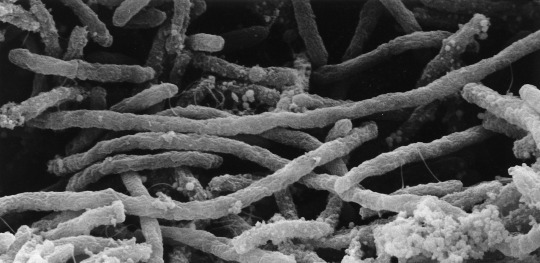
8 notes
·
View notes
Text
ROUND 1: PART 3


Propaganda under cut
Moondragon (Heather Douglas)
● What's more gay then being able to turn into a dragon? Being able to turn into a dragon and have your girlfriend ride you into battle.
After her parents were killed by Thanos, Heather Douglas was raised on Titan, the moon of Saturn, in a monastery where she trained in martial arts and psychic powers. During her training, she met and faced the Dragon of the Moon, defeating it but not without it leaving a psychic trace in her mind. She hung out on Earth being kind of an antihero and a bisexual icon, before meeting her girlfriend Phyla-Vell and returning to space.
During the Annihilation event, a confrontation with the Dragon of the Moon turned her into a dragon permanently, like, 'you'll never be human again' permanently, and Phyla decided that this was not grounds for a break up, because she's also iconic. She died, and Phyla became Death to resurrect her (I'd say you can't bury these gays, they'll keep coming back, but unfortunately Phyla's been dead since 2010). She's spent some time being able to transform to dragon form freely but I don't think that's been used since her death? She'll always be a dragon in my heart.
Anyways I love her. She's a huge bitch. She was introduced under the code name Madame MacEvil. She's bald and her eyeliner is constistently on point. I unfortunately still am waiting for her to show up in the MCU (beyond an off screen mention (oh yeah her dead dad is Drax the Destroyer)
Chromie (Chronormu)
● Chronormu is a masculine name, but Chromie shows herself in humanoid form as a female gnome. For a long time, this was debated among fans, to the point even Blizzard took initiative by... having her make jokes about it in Heroes of the Storm. Not a great look. A few years later, queer identities were much more mainstream 'acceptable', and an official short story was made that canonized her being trans
#gaydragontournament#polls#tournament poll#dragons#dragon#moondragon#heather douglas#marvel comics#Guardians of the Galaxy#gotg moondragon#gotg#Chromie (Chronormu)#chromie#chronormu#world of warcraft#wow#warcraft series
10 notes
·
View notes
Text
Phylum #16: Onychophora, the velvet worms!
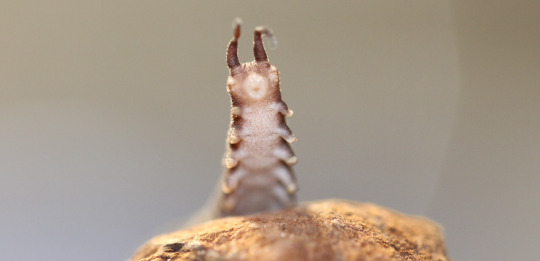

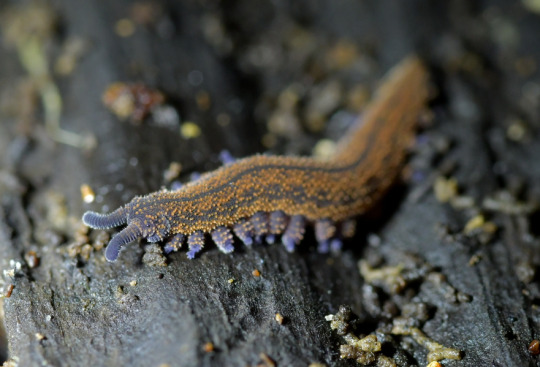
"Lobopods", unarmored relatives of arthropods, have a long and rich history. While early forms like Hallucigenia remain unclear as to their affinities, another lineage had already split from the first arthropods. Velvet worms still thrive today, having left the seas for rainforests and humid crevices.
Instead of the arthropods' articulated exoskeletons, velvet worms kept a softer, unarticulated cuticle, with tiny round "papillae" covered in bristles and scales providing their velvet-like appearance. They still moult their cuticle regularily, but do not gain new legs doing so - the babies already look like miniature adults!
Adapted to many terrains thanks to their flexible body and clawed legs, velvet worms are true ambush predators. They come with a special weapon: a glue-like slime, immobilizing prey and repelling predators, shot from appendages on each side of their mouth.
Velvet worms are also intelligent, social creatures. At least one species, Euperipatoides rowelli, is known for hunting together, living in groups of up to 15 individuals with complex interactions establishing their social hierarchy. Individuals within a group are often closely related, with most species giving live birth and taking care of their young!



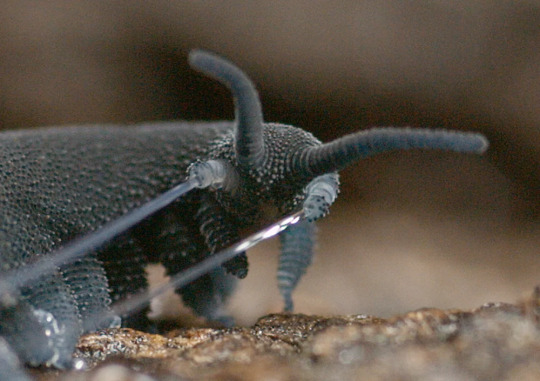
374 notes
·
View notes
Photo

Nun lifting the sacred barque of Ra. Ra is represented in the middle as Khepry in His form of sacred scarab, flanked by seven Gods, three at left and four at right; on the top, Nut supporting Osiris represented with His arms and hands raised to receive the Solar disk. Scene from the papyrus of Anhai, "Chantress of Amon over the Phylae", "Leader of Musicians of Osiris", "Leader of Musicians of Nebtu and Khnum", and "Lady of the House"; XX Dynasty (ca. 1186–1070 BCE). Now in the British Museum... #iregipto #egyptpassion #mbplanet #ancientegypt #egyptology #kemetic #ancientegyptian #egyptologist #anticoegitto #egittologia #egiptologia #antiguoegipto #religion #pagan #paganism #polytheism #kemet #egypt #archaeology #egyptiancalendar #nut #nun #osiris #sun #khepri #ra #gods #goddess #goddesses #dailygods https://www.instagram.com/p/ChNEBKCrLSd/?igshid=NGJjMDIxMWI=
#iregipto#egyptpassion#mbplanet#ancientegypt#egyptology#kemetic#ancientegyptian#egyptologist#anticoegitto#egittologia#egiptologia#antiguoegipto#religion#pagan#paganism#polytheism#kemet#egypt#archaeology#egyptiancalendar#nut#nun#osiris#sun#khepri#ra#gods#goddess#goddesses#dailygods
184 notes
·
View notes
Text
I love how in annihilation conquest Heather turns into a dragon and Phyla just. Doesn't hesitate at all to assure her that she doesn't mind dating her in this form. I get that it's romantic but also it took sis 0.05 seconds to pick the donkey from shrek route: lesbian edition.
#honestly? good for her#we do need more representation for gay monsterlovers in media#heather douglas#phyla vell#moondragon#quasar#nikoletta reads comics#my post
21 notes
·
View notes
Text

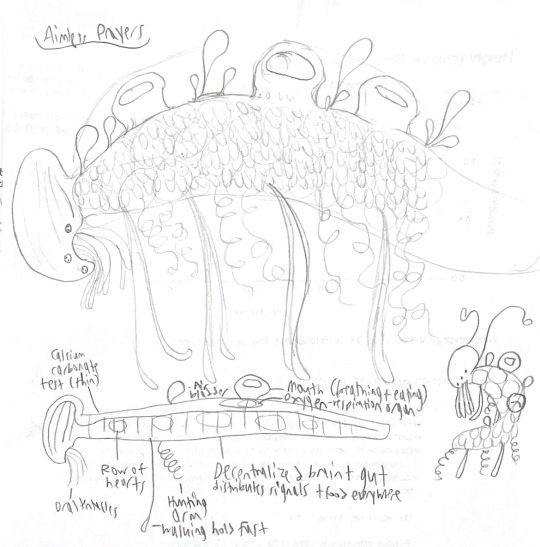

More sophonts for the phyla challenge!
- The Sylvans, terrestrial orthonectids with a vaguely plantlike life cycle. On this earth, they filled the role that plants did on ours, forming a collective entity out of a small grove of near-sophont individuals. They prefer to stick to themselves, as they have enough company with each other.
- The Aimless Prayers, sapient siphonophores and a true hivemind, each organism acting as a slightly more complex cell powering a full decentralized brain. They’re nearly planktonic, which is unique for a sophont, and many are highly religious, hoping that fate and the current sweep them on the right path.
- The Pact of Weathering the Storm, sophont arrow worms originating around the Arctic circle. Their main governing body is a mass of loosely intertwined herds, although as with most sophonts, the specifics can vary and be interpreted in any number of ways. The individual pictured here is walking a pet “reptilian” “dog”.
8 notes
·
View notes
Photo

aka, “i’m not dead. let’s get dinner.”
hey everyone! i FINALLY have a modicum of free time for a few weeks, so i thought it’d be fun to celebrate! we’re going to vote for our top 15 doctor who episodes, and i’m going to make gifsets of the results!
the rules:
preferably follow this donna noble enthusiast
choose up to 15 episodes on this form
reblog this post
wait until i post the gifsets
profit
i’m going to keep this poll open until december 28th, then start making the sets! also note that you don’t have to be a who aficionado to vote- even if you’ve only seen, say, “vincent and the doctor,” feel free to come vote for “vincent and the doctor” and then peace out. (and then, you know, go watch the rest of it, because when who is good it’s good.)
tagging some who mutuals under the cut!
@adamronans @laowen @eohwyyn @billhaders @brittas-perry @yasminkahns @katherineebishop @bellamysgriffin @hopefulbeautifulfool @nikolatexla @phyla-vells @kamadosnezukos no pressure for any of you to do it, but if you’re interested here it is :)
64 notes
·
View notes
Note
If you had the chance to fix some comic storylines that you thought were bad or a waste of potential which ones would it be.
I'm taking this as an excuse to tell you how I would rewrite every GOTG run barring 2008 and 2020.
2013
I think this run would've been. so fucking cool. if original sin dropped the bombshell that the Peter Quill we've been following this whole time is the Peter Quill of the Cancerverse and 616 Pete is still trapped in the Cancerverse with Rich.
It'd do a lot to explain the wonky characterization-- and it'd give the Guardians themselves a clear-cut mission. the 2013 kind of meanders a lot with no clear goal, so it'd benefit from a straightforward "save x from y" type of mission.
Peter & Rocket's friendship would be a big focus here; I think if Pete was replaced, Rocket would be one of the first to pick up on it
Plus, Adam could show up <3
2015
Extrapolating the Wanted arc into something more- by this point in the GOTG comics, they've pissed off every major empire (Kree in Black Vortex, Shi'ar in TOJG, Spartax by Peter's existence, Badoon by Gamora's existence, etc) and it'd be fun if it was just... every galactic empire is gunning for their heads & they've got to keep up the whole guarding the galaxy through that.
I'd have Cammi come back in this, like if we've gotta have her with the Ravagers then fine, she's there to take them in 'cause she's pissed that they never found & she got stuck with Arcade.
It gives Drax some limelight & focuses on how he navigates being a father
Nebula as the main villain, having the Graces as arc long bad guys for the team to fight. Neb obviously has her 616 personality & is in this for the bounty - but Gamora can take it personally due to the drama with the Graces
All New All Different/2018
Magus as the main villain this seems so obvious to me
I'd keep the Infinity Wars stuff, just in a way that makes sense. Gamora is working with Magus to get her soul back because he's also got a part of him stuck in there
It's all a scheme by Magus & Goddess to escape Soul World; Goddess has shown to be able to brainwash Gamora before, so we can put that on that
I'd also not. downplay the Ultron side of things. Conquest was fucking traumatizing for this team
Gamora's past with the Phalanx would also work well with the Magus/Goddess thing; maybe she's got it in her head that if she gets her soul back, she'll have purpose again
Mantis would be there for the Ultron side of things
I would work Phyla's resurrection in there somehow. 616 Phyla, specifically, like I don't think anything fancy needs to be done at all, Thanos has been resurrected so many times it'd be simple to say Oblivion brought her back to combat Magus&Goddess
Can work the Groot stuff into the themes of Soul & Trauma like... Groot died in Conquest, he was lit on fire, and grew back as a little stump. So the Groots are killing worlds... but it's always worlds that Ultron was going to target & it's a fucked form of mercy
2019
In stories that focus primarily on Thanos & the Universal Church of Truth as the antagonists, I would simply not make it the Peter Quill show & instead let Gamora & Warlock take the lead
If Starmora has to happen, I'd have Peter's arc be more about trust & how to keep it, contrasting with Gamora's arc of learning to give second chances after people hurt her
I'd also. address how Adamora broke up, like delve into why, bring in Atleza in at least a mention, etc
2023
I'd keep Grootfall as some kind of corrupting force in the Manifold Territories but not as the reason they're there
Instead
I'd use the whole "the Manifold Territories are from beyond the known universe" and have Peter be the one insisting they go. Have him aware of the risk this could pose to teammates (maybe have it have something to do with damaged souls-- Gamora's & Drax's are healed after Infinity Wars, etc, but Groot is still vulnerable from the Gardener) but he does not care because if it's beyond the known universe, it's beyond the sun
He's trying desperately to get back to Morinus
Mantis has brainwashed the others into coming & it becomes an inverse of GOTG2008; instead of Peter doing all of this for altruistic reasons, it's because he wants to go home
Continuing to inverse 2008 - show how the GOTG have changed each other through their refusal to kill Groot. Peter shot Warlock; now, years later, he can't do that to Groot. Being a Guardian has changed him
Like show the positive & negative effects that the Guardians have had on everyone
13 notes
·
View notes